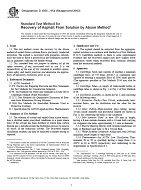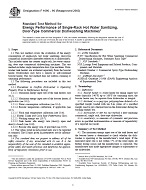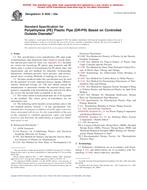1.1 This test method covers the determination of gaseous 2,4-toluene diisocyanate (2,4-TDI) and 2,6-toluene diisocyanate (2,6-TDI) in air samples collected from workplace and ambient atmospheres.
1.2 Differential air sampling is performed with a segregating device., The gaseous fraction is collected on a glass fiber filter (GFF) impregnated with 9-(N-methylaminomethyl) anthracene (MAMA).
1.3 The analysis of the gaseous fraction is performed with a high performance liquid chromatograph (HPLC) equipped with ultraviolet (UV) and fluorescence detectors.
1.4 The analysis of the aerosol fraction is performed separately as described in Ref
1.5 The range of application of this test method, utilizing UV and a fluorescence detector, is validated for 0.02 to 4.2 g of monomer 2,4- and 2,6-TDI/2.0 mL of desorption solution, which corresponds to concentrations of 0.001 to 0.28 mg/m³ of TDI based on a 15-L air sample. This corresponds to 0.15 to 40 ppb(V) and brackets the established TLV value of 5 ppb(v).
1.6 The average correlation coefficient is 0.9999 and 0.9999 for the UV detector, for 2,6 and 2,4-TDI, respectively. For the fluorescence detector, the average correlation coefficient is 0.9803 and 0.9999 for 2,6 and 2,4-TDI, respectively. These values were obtained from seven standard solutions distributed along the calibration curve, each standard being injected six times, with the curve having been done twice by different operators.
1.7 The quantification limit for 2,6-TDI monomers is 0.007 µg/2 mL of desorption solution, which corresponds to 0.0005 mg/m 3 for 15-L sampled air volume for the UV detector. For the fluorescence detector, the quantification limit is 0.003 µg/2 mL of desorption solution, which correspond to 0.0002 mg/m³ for a volume of 15 L collected in air. These values are equal to ten times the standard deviation obtained from ten measurements carried out on a standard solution whose concentration of 0.02 µg/2 mL is close to the expected detection limit.
1.8 The quantification limit for 2,4-TDI monomers is 0.015 µg/2 mL of desorption solution, which corresponds to 0.001 mg/m 3 for 15-L sampled air volume for the UV detector. For the fluorescence detector, the quantification limit is 0.012 µg/2 mL of desorption solution, which corresponds to 0.0008 mg/m³ for a volume of 15 L of collected air. These values are equal to ten times the standard deviation obtained from ten measurements carried out on a standard solution whose concentration 0.02 g/2 mL is close to the expected detection limit.
1.9 2,4- and 2,6-TDI isomers can be separated using a reversed phase C18 column for HPLC. The UV and fluorescence detector response factor (RF) ratio characterize each isomer.
1.10 A field blank sampling system is used to check the possibility of contamination during the entire analytical process.
1.11 The values stated in SI units are to be regarded as the standard.
1.12 This standard does not purport to address all of the safety concerns, if any, associated with its use. It is the responsibility of the user of this standard to establish appropriate safety and health practices and determine the applicability of regulatory limitations prior to use.
Product Details
- Published:
- 04/10/1996
- Number of Pages:
- 6
- File Size:
- 1 file , 41 KB


